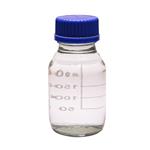Dimethyl mercury is a volatile colorless liquid with faint sweet odor. Molecular weight= 230.67;Boiling point=96℃. Soluble in water. Methyl mercury chloride is a colorless, crystalline solid. Molecular weight= 251.08; Freezing/Melting point=170℃. Practically insoluble in water; solubility= ,0.1 mg/mL at 21℃.
industrial and agricultural uses of the compound
and its industrial production have generally been
abandoned because of its high toxicity. Methylmercury
remains of considerable concern, however, because of its
continuous formation in the environment. In the aquatic
environment, elemental mercury is first oxidized to the
mercuric mercury ion (Hg2+
), which may then become
methylated to form methylmercury compounds, either by
chemical or microbiologically catalyzed reactions. Methylmercury
is accumulated by fish and marine mammals and
attains its highest concentrations in large predatory species at
the top of the aquatic and marine food chains. By this means,
methylmercury enters the human diet. Thus, minimization of
environmental mercury contamination is imperative.
Methylmercury(II) chloride is used as a precursor for the preparation of methyl mercury acetate. It is used as a specific reagent (electron stain) for sulfhydryl groups in biological materials like protein as well as demonstration in electron microscopy.
ChEBI: Methylmercury chloride is a mercury coordination entity, a one-carbon compound and a chlorine molecular entity. It is functionally related to a methylmercury(.).
White microcrystals or crystals.
Aqueous solutions at a concentration of 0.25 mg / mL are stable for 3 weeks in the dark at room temperature. Aqueous 0.0001 M solutions show no degradation after 17.1 hours of midday sunlight. High intensity UV irradiation of solutions causes decomposition .
METHYLMERCURY(II) CHLORIDE may be sensitive to light.
Flash point data for METHYLMERCURY(II) CHLORIDE are not available; however, METHYLMERCURY(II) CHLORIDE is probably nonflammable.
Poison by ingestion,
intramuscular, intravenous, and intraperitoneal routes. Questionable
carcinogen with experimental carcinogenic
and teratogenic data. Human mutation data
reported. Experimental reproductive effects.
When heated to decomposition it emits very
toxic fumes of Cland Hg. See also
MERCURY COMPOUNDS.
Alkyl mercury compounds have been used as seed disinfectants and for fungicides. They have also been used in organic synthesis
If this chemical gets into the eyes, remove any contact lenses at once and irrigate immediately for at least 15 min, occasionally lifting upper and lower lids. Seek medical attention immediately. If this chemical contacts the skin, remove contaminated clothing and wash immediately with soap and water. Seek medical attention immediately. If this chemical has been inhaled, remove from exposure, begin rescue breathing (using universal precautions, including resuscitation mask) if breathing has stopped and CPR if heart action has stopped. Transfer promptly to a medical facility. When this chemical has been swallowed, get medical attention. Give large quantities of water and induce vomiting. Do not make an unconscious person vomit. Antidotes and special procedures for medical personnel: The drug NAP (n-acetyl penicillamine) has been used to treat mercury poisoning, with mixed success. Note to physician: For severe poisoning BAL [British AntiLewisite, dimercaprol, dithiopropanol (C3H8OS2)] has been used to treat toxic symptoms of certain heavy metals poisoning including mercury. Although BAL is reported to have a large margin of safety, caution must be exercised, because toxic effects may be caused by excessive dosage. Most can be prevented by premedication with 1-ephedrine sulfate (CAS: 134-72-5).
A number of authors have reported carcinogenic effects in
rats and mice exposed orally to methylmercury. An association
between methylmercury exposure and renal adenocarcinoma
was shown in male mice, but no increase in tumor
incidence was detected in rats. These findings are supported
by reports on methylmercury-induced degeneration of DNA,
and inhibition of the formation of the mitotic spindle.
Intoxications with alkoxialkyl or aryl compounds are similar
to intoxications with inorganic mercury compounds, as
these organomercurials are relativelyunstable. Alkylmercury
compounds, such as methylmercury, result in a different
syndrome due to the stability of the mercury–methyl binding.
The earliest symptoms in adults are paresthesias in the
extremities and the face, particularly around the mouth.
Later on, disturbances occur inthe motor functions, resulting
in ataxia and dysphasia. The visual field is decreased, and,
in severe cases, may result in total blindness. These symptoms
were observed in large-scale poisonings caused by
methylmercury.
Color Code—Blue: Health Hazard/Poison: Store in a secure poison location. Prior to working with this chemical you should be trained on its proper handling and storage. These compounds should be stored in a refrigerator or a cool, dry place away from oxidizers. A regulated, marked area should be established where this chemical is handled, used, or stored in compliance with OSHA Standard 1910.1045
Mercury compounds n.o.s. require a shipping label of “POISONOUS/TOXIC MATERIALS.” They fall in DOT Hazard Class 6.1.
Recrystallise it from absolute EtOH (20mL/g). at 206nm (� 1.37). [See EtHgCl above; Breitinger et al. J Organomet Chem 256 217 1983,max Slotta et al. J Prakt Chem 120 249 1929, Waugh et al. J Phys Chem 59 395 1955, Beilstein 16 IV 1729.]
Strong oxidizers, such as chlorine. May be sensitive to light.


